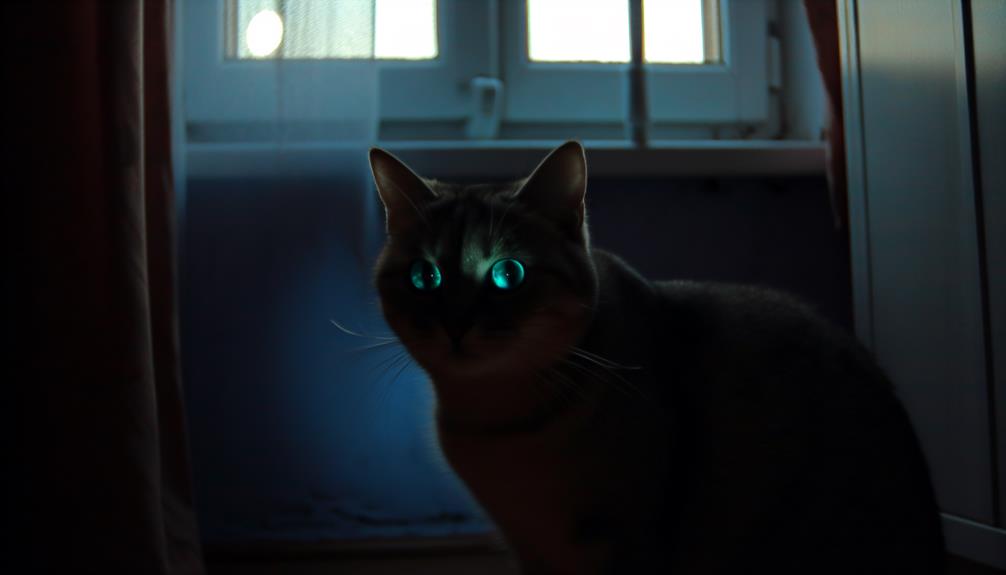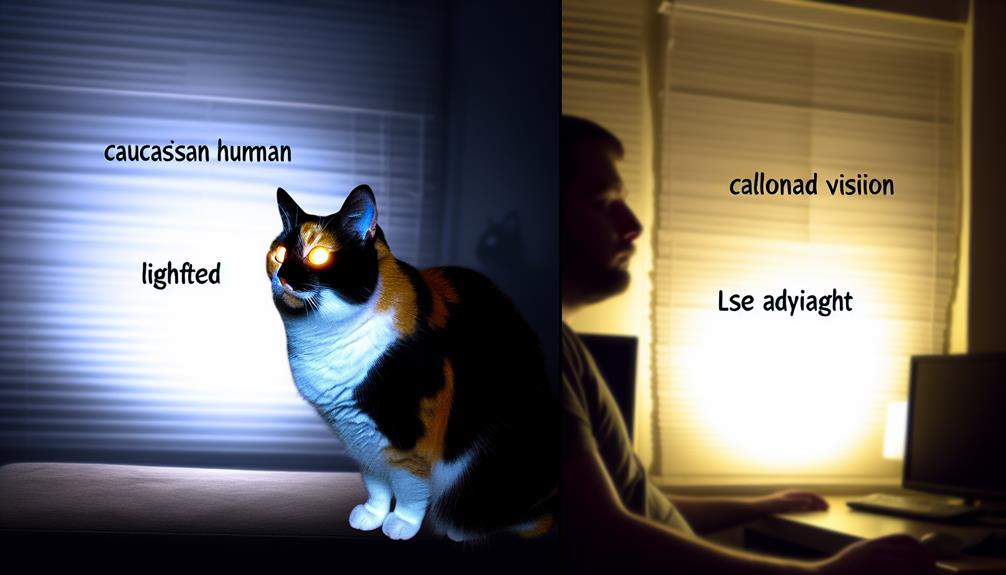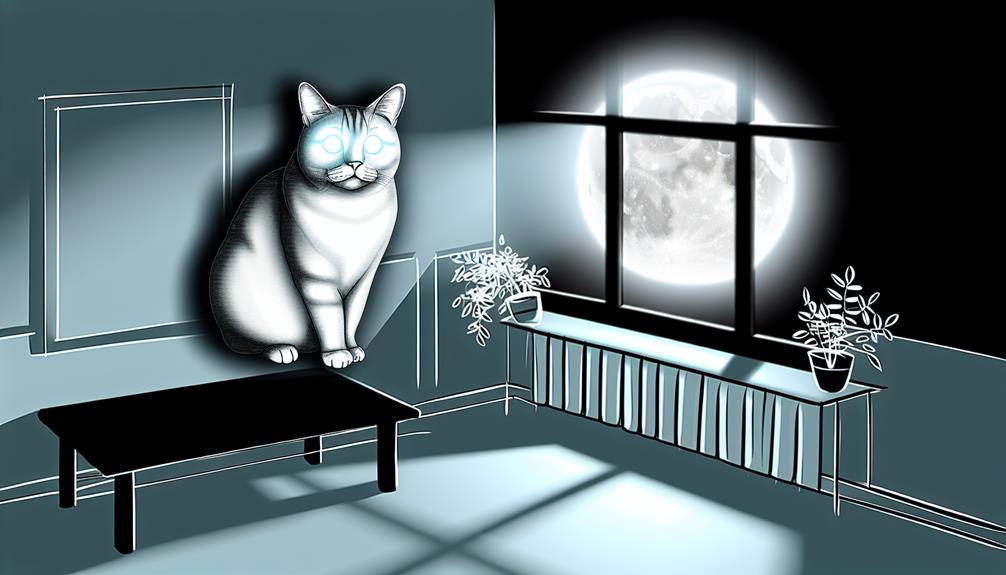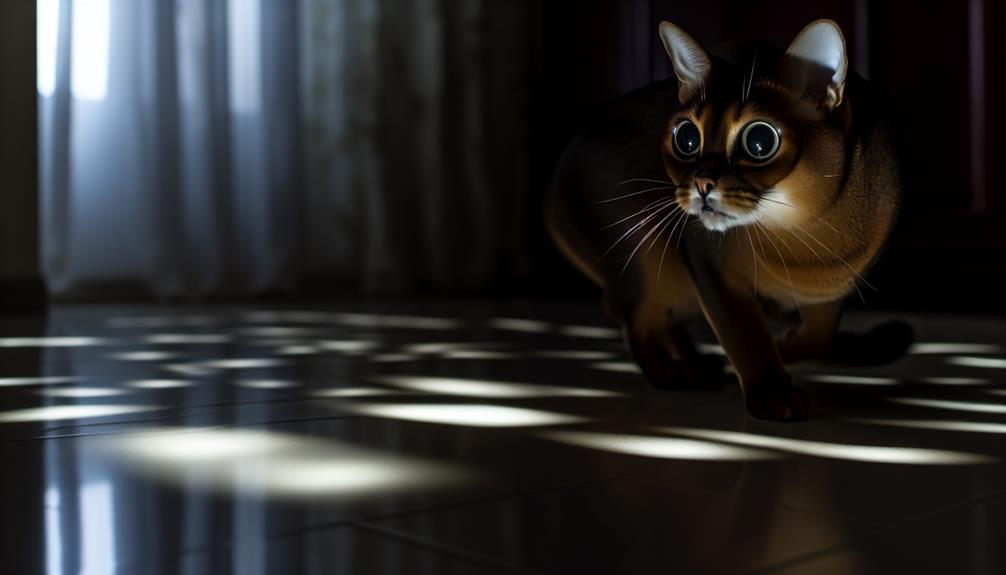You might not know that cats can't actually see in complete darkness, but their eyes are marvelously adapted for low-light conditions. Their vision is enhanced by a higher density of rod cells and a unique structure called the tapetum lucidum, which reflects light and improves night vision. This means they can detect light levels six times lower than what humans need. However, even cats require some ambient light to navigate effectively. Want to understand how your feline friend's eyes work and why they seem to see so well at night? Let's explore their fascinating visual abilities.
The Cat's Eye Structure
Although it may seem mysterious, the structure of a cat's eye reveals why they possess such remarkable night vision. At the core of this ability is the dynamic pupil dilation, which allows cats to adjust the amount of light entering their eyes with exceptional precision. In low-light conditions, a cat's pupils will dilate to their maximum size, enabling the eye to capture as much available light as possible. This dilation is considerably more pronounced than in human eyes, contributing to their superior night vision.
Another vital aspect of a cat's eye structure is the tapetum lucidum, a layer of tissue located behind the retina. This structure acts like a mirror, reflecting light that has passed through the retina back into the eye, giving photoreceptor cells a second chance to absorb it. This reflection is responsible for the eerie glow you sometimes see when light hits a cat's eyes in the dark. It's not mere happenstance; it's an evolutionary adaptation that greatly increases the efficiency of their vision in dim conditions.
Eye color also plays a subtle yet significant role in a cat's night vision. The pigmentation in the iris, which determines eye color, can affect how much light is naturally filtered before it reaches the retina. Darker-colored eyes tend to absorb more light, while lighter-colored eyes may reflect more. This variation, though minor compared to pupil dilation and the tapetum lucidum, adds another layer of complexity to their visual capabilities.
Understanding these elements of a cat's eye structure elucidates why they navigate the night with such ease, blending anatomical sophistication with evolutionary finesse.
Rods and Cones
Beyond the structural components of the cat's eye, the cellular makeup also plays a vital role in their exceptional night vision. The retina of a cat's eye contains two primary types of photoreceptor cells: rods and cones. Each type serves a distinct function that, collectively, accounts for the cat's superior ability to see in low-light conditions.
Rods are the cells responsible for vision in dimly lit environments. In cats, rod distribution is considerably higher than in humans, meaning they have a greater number of rods per unit area in their retinas. This high rod density contributes to their heightened sensitivity to light, allowing them to detect even the faintest glimmers of light at night. The rods are highly specialized for detecting motion and changes in brightness, which is essential for nocturnal hunting.
On the other hand, cones are responsible for color vision and visual acuity. While cones function best in bright light, cats have fewer cones compared to humans. This lower cone count means that cats don't perceive color as vividly as humans do, but it's a trade-off that enhances their night vision. The cone function in cats is sufficient for distinguishing basic colors, particularly in low-light conditions where their enhanced rod distribution takes precedence.
The Tapetum Lucidum

You might wonder how cats' eyes can function so effectively in the dark, and the answer lies in the tapetum lucidum. This reflective eye structure considerably enhances night vision by amplifying available light, consequently allowing cats to see in conditions where human vision would falter. By reflecting light back through the retina, the tapetum lucidum maximizes photon absorption, thereby improving visual sensitivity in low-light environments.
Reflective Eye Structure
When examining the remarkable nocturnal vision of cats, one must consider the role of the tapetum lucidum, a specialized reflective layer located behind the retina. This structure greatly enhances a cat's ability to navigate and hunt during low-light conditions, aligning with their nighttime behavior and predatory instincts. The tapetum lucidum acts by reflecting incoming light that has passed through the retina back into the photoreceptor cells, effectively giving these cells a second chance to absorb the light.
This reflective mechanism is essential for amplifying the minimal light available in dark environments, thereby optimizing visual sensitivity. The tapetum lucidum's efficiency contributes to a cat's exceptional ability to detect and track prey under the cover of darkness, a critical aspect of their hunting instincts. By doubling the light that photoreceptors can utilize, it provides cats with a distinct advantage over many other animals that lack this feature.
Furthermore, the specific arrangement and composition of the tapetum lucidum, consisting of guanine crystals, enhance its reflective properties. This facilitates superior light amplification, enabling cats to perceive their surroundings with greater detail and precision. Consequently, the tapetum lucidum is indispensable for the nocturnal prowess of felines.
Enhanced Night Vision
The enhanced night vision of cats, primarily facilitated by the tapetum lucidum, demonstrates a sophisticated adaptation to low-light environments. The tapetum lucidum, a specialized layer of cells located behind the retina, reflects light that passes through the retina back into the eyes. This reflection allows for a second opportunity to capture light, greatly enhancing vision in dim conditions.
You'll find that this anatomical feature is essential for a cat's nocturnal behavior. When engaging in hunting activities during the night, cats rely heavily on their enhanced night vision. The tapetum lucidum amplifies the available light, thereby optimizing their ability to detect and track prey, even in near-total darkness. This is vital for their survival and effectiveness as predators.
Moreover, the structural design of the tapetum lucidum is fine-tuned to support the feline's predatory instincts. It fundamentally doubles the efficiency of photoreceptor cells in the retina, enhancing sensitivity to low light levels. Consequently, the integration of the tapetum lucidum is not merely a passive trait but a critical component driving the nocturnal behavior and hunting instincts of cats, ensuring their dominance in low-light environments.
Light Amplification Mechanism
A marvel of biological engineering, the light amplification mechanism embodied by the tapetum lucidum is fundamental to a cat's superior night vision. Located behind the retina, this reflective layer enhances light perception by reflecting light that passes through the retina back into the photoreceptor cells. This process effectively doubles the amount of light available, providing cats with a distinct advantage during their nocturnal behavior. The tapetum lucidum's cellular structure is composed of guanine crystals, which act as tiny mirrors, optimizing the reflection of light.
| Feature | Emotional Impact |
|---|---|
| Reflective Layer | Awe at natural design |
| Enhanced Vision | Envy of night prowess |
| Guanine Crystals | Fascination with detail |
| Nocturnal Skills | Admiration of agility |
This sophisticated mechanism not only amplifies dim light but also contributes to the characteristic eye shine seen when a cat's eyes are illuminated in the dark. By increasing photon capture, the tapetum lucidum guarantees that cats maintain high visual acuity even in minimal light conditions. Such an evolutionary adaptation underscores the cat's predatory efficiency, allowing for precise navigation and hunting under the cover of darkness. It's this biological ingenuity that allows your feline companions to thrive when the world is cloaked in shadow.
Low-Light Vision Capabilities
Cats possess remarkable low-light vision capabilities that allow them to navigate and hunt efficiently in dim environments. This aptitude is vital for their nocturnal behavior, as many feline hunting activities mainly occur during the twilight hours. The underlying anatomy of a cat's eyes greatly contributes to their enhanced ability to see in low-light conditions.
The feline retina contains a higher ratio of rod cells compared to cone cells. Rod cells are more sensitive to light and motion, making them essential for low-light vision. In contrast, cone cells are responsible for color vision and perform best under brighter conditions. This rod-dominant retinal structure allows cats to detect even the slightest movements in near darkness, an asset for nocturnal predators.
Another important component is the tapetum lucidum, a reflective layer situated behind the retina. This structure acts like a mirror, reflecting incoming light back through the retina and effectively amplifying the available light. The tapetum lucidum enhances the photoreceptors' ability to capture light, thereby improving the cat's night vision. This anatomical feature not only boosts their visual sensitivity but also accounts for the characteristic glow of a cat's eyes when illuminated in the dark.
The large corneal surface and dilatable pupils further augment a cat's low-light vision. Their pupils can expand greatly, allowing more light to enter the eye. Additionally, the large cornea aids in gathering and directing light towards the retina. This combination of features guarantees that cats can maintain a high degree of visual acuity in low-light scenarios, maximizing their hunting efficiency and survival in natural habitats.
Comparing Cat and Human Vision

When comparing feline and human vision, you'll notice significant differences in light sensitivity and night vision mechanisms. Cats possess a higher number of rod cells in their retinas, enhancing their ability to detect low light levels. Additionally, the presence of the tapetum lucidum in cats' eyes amplifies available light, giving them superior nocturnal vision compared to humans.
Light Sensitivity Differences
Understanding the light sensitivity differences between feline and human vision reveals fascinating adaptive mechanisms. Cats possess superior light perception, a trait born out of their need for environmental adaptation. While humans have evolved to rely heavily on daylight, cats are crepuscular, active primarily during dawn and dusk, necessitating a heightened sensitivity to low light conditions.
Consider these key differences:
- Retinal Structure: Cats' retinas have a higher density of rod cells, approximately six to eight times more than humans, which are essential for low-light vision.
- Tapetum Lucidum: This reflective layer behind the retina in cats enhances light capture, effectively doubling the light available to their photoreceptors.
- Pupil Dynamics: Cats have vertical slit-shaped pupils that can expand considerably, allowing them to regulate light intake more efficiently than the round pupils of humans.
These adaptations allow cats to maximize their light perception in dim environments. Humans, on the other hand, benefit from a greater concentration of cone cells, responsible for color vision and sharpness, aspects less vital for cats. By understanding these differences, you can appreciate the evolutionary trade-offs each species has made to optimize their vision for their respective lifestyles.
Night Vision Mechanisms
In low-light conditions, the mechanisms underpinning night vision in cats and humans diverge markedly due to evolutionary specialization. Cats, adapted for nocturnal behavior and efficient hunting strategies, possess a higher density of rod cells in their retinas compared to humans. These rod cells are more sensitive to low light, enabling cats to detect minimal light sources. Additionally, the feline eye includes a structure called the tapetum lucidum, a reflective layer behind the retina that amplifies the amount of light available to photoreceptors by reflecting it back through the retina. This greatly enhances their night vision capabilities.
In contrast, humans have a higher concentration of cone cells, which are optimized for color vision and visual acuity in brighter light conditions. The absence of a tapetum lucidum and a lower rod density in the human eye mean our night vision is comparatively poor. Human eyes rely more on ambient light and cannot match the sensitivity required for effective nocturnal behavior. As a result, while cats evolved for predation in low-light environments, humans developed vision suited for daylight activities. These evolutionary distinctions underscore the specialization in night vision mechanisms between the two species, reflecting their disparate ecological niches and behavioral necessities.
Myths About Cat Vision
Despite popular belief, cats don't possess the ability to see in complete darkness. This common misconception often leads to various feline myths that can distort our understanding of cat vision. While it's true that cats have superior night vision compared to humans, their ability to navigate in absolute darkness is limited. Let's dispel some prevalent vision misconceptions concerning our feline companions.
First, it's important to understand that cats rely on a combination of anatomical features to see well in low-light conditions, not in pitch-black environments. Their retinas contain a higher proportion of rod cells, which are more sensitive to dim light, compared to the cone cells that are more effective in bright light.
Here are three common myths about cat vision:
- Cats can see in complete darkness: In reality, cats need at least some ambient light to see. Their eyes are highly efficient at amplifying available light but can't function in total darkness.
- Cats see in color exactly like humans: Feline color vision is dichromatic, meaning they primarily see shades of blue and green. They lack the ability to distinguish between red and green, leading to a more limited color spectrum than humans.
- Cats have the same depth perception as humans: Due to their eye placement, cats have a wider field of view but reduced depth perception. This affects how they judge distances, especially at closer ranges.
Enhancing Your Cat's Night Vision

Given the misconceptions about cat vision, it's clear that understanding how to enhance your cat's night vision can greatly benefit their nocturnal activities. While cats inherently possess superior night vision compared to humans, certain measures can optimize this capability, making them even more adept at nighttime activities and feline hunting.
Firstly, you should guarantee your cat's diet includes taurine, an essential amino acid vital for retinal health. Taurine deficiency can lead to impaired vision, particularly in low-light conditions. High-quality cat food usually contains adequate taurine, but you can also consult your veterinarian for supplements.
Next, consider the environmental lighting. Although cats can see in minimal light, complete darkness can still be challenging. Installing dim, motion-activated night lights can help illuminate their pathways without disrupting their natural behavior. These lights should emit wavelengths that don't interfere with their acute night vision, such as red or infrared light.
Moreover, regular eye check-ups are necessary. Conditions like cataracts or retinal degeneration can go unnoticed and greatly impair night vision. Early detection and treatment can preserve your cat's ability to navigate and hunt efficiently after dark.
Stimulating your cat's natural hunting instincts through interactive toys and puzzles can also enhance their visual acuity. These activities mimic the challenges of feline hunting, encouraging them to rely on their visual capabilities in low-light settings.
Lastly, maintaining a stress-free environment is vital. Stress can affect a cat's overall health, including vision. Providing safe, quiet spaces and minimizing abrupt changes in their surroundings will help keep their night vision sharp.
Conclusion
Understanding your cat's night vision is fascinating. Remember, cats can see in light levels six times lower than humans can. Their superior low-light vision stems from a combination of specialized rod cells, the tapetum lucidum, and dilatable pupils. While they can't see in complete darkness, their ability to navigate and hunt in dim conditions is unparalleled. So, next time you see your cat prowling at dusk, appreciate the remarkable evolutionary adaptations at play.
